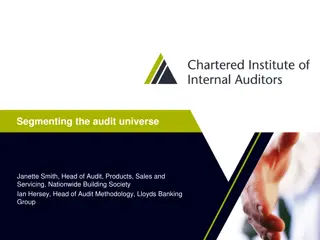Customer Segmentation and Usage Patterns Analysis
This research delves into segmenting customers based on summer load shapes and matching usage patterns to demographic profiles using census data. It analyzes daily interval volume readings for residential customers, identifies load shape clusters, and explores their distribution across different areas, particularly in Chicago. The data and methods involve k-means clustering and logistic regression to determine customer likelihood based on attributes. Insights from the study provide a comprehensive view of customer behavior and preferences in relation to income levels and geographic locations.
Download Presentation

Please find below an Image/Link to download the presentation.
The content on the website is provided AS IS for your information and personal use only. It may not be sold, licensed, or shared on other websites without obtaining consent from the author.If you encounter any issues during the download, it is possible that the publisher has removed the file from their server.
You are allowed to download the files provided on this website for personal or commercial use, subject to the condition that they are used lawfully. All files are the property of their respective owners.
The content on the website is provided AS IS for your information and personal use only. It may not be sold, licensed, or shared on other websites without obtaining consent from the author.
E N D
Presentation Transcript
Six Unique Customer Types: Segmentation by Summer Load Shape Jeff Zethmayr, Director of Research David Kolata, Executive Director Citizens Utility Board
Usage Types and Demographic Analysis Matching Summer Usage Patterns to Demographic Profiles using Census Data Anonymous interval data grouped according to average summer weekday Customers matched with block group level census data: age, median income, educational attainment, household makeup, age/size/density of units Flatter load shapes associated with lower income areas, urban areas Peakier load shapes associated with higher income and suburban, exurban, and rural areas
Data and Methods Data Sets Daily interval volume readings for 2.5m anonymous residential customers, with geographic identifiers Block group data from American Community Survey 2017 Analysis Individual load shapes calculated as their average summer weekday usage, normalized to their maximum load Grouped together using k-means clustering algorithm, which minimizes the statistical difference between observations data points Logistic regression using matched census data determines likelihood of a cluster member to live in an area with particular attributes
Cluster Load Shapes Clusters 1, 3, and 5 have higher, peakier usage, with slight timing differences Clusters 2, 4, and 6 have lower, flatter usage
Cluster Distribution Clusters 2, 4, and 6 predominant in Chicago Clusters 1, 3, and 5 in surrounding suburbs, exurbs Cluster 2 areas found in smaller city centers
Cluster Distribution: Chicago West and South sides predominantly Cluster 2 Cluster 1 common in closer suburbs, Near North side Far North side more diverse
Cluster 1 Profile Wide, mid-evening, 1 kW peak Base cluster 706 thousand customers 380k ComEd, 327k AIC Average demographics in ComEd Load shape closest to overall ComEd
Cluster 2 Profile Flattest load shape 422 thousand customers 270k ComEd, 151k AIC Live in Chicago, or urban center (2.5x more likely than average) Lower income (2.5x more likely to qualify for LIHEAP) High Education (1.3x grad school, 1.2x PhD) Likely two non- exclusive groups: urban young professionals and low- income communities
Cluster 3 Profile Late afternoon, 1 kW peak 493 thousand customers 277k ComEd, 216k AIC Mostly exurban/rural Larger homes (1.5x more than 5 rooms) Older (2x over 56) Less educated Age and afternoon usage suggest sub/exurban retirees
Cluster 4 Profile Low volume, with late- evening .5 kWh peak 283 thousand customers 197k ComEd, 86k AIC Mostly in Chicago Low-income (2.6x <$50k, 1.8k LIHEAP) Likely to have no HS degree (1.3x) or have advanced degree (2x Grad, 1.3x PhD) Youngest cluster (1.9x <33)
Cluster 5 Profile Evening, ramping .95 kW peak 452 thousand customers 257k ComEd, 194k AIC Primarily exurban Educated (1.3x BA) Likely middle class, medium sized homes (1.2x 4-5 rooms, 0.7x >$150k)
Cluster 6 Profile Lowest volume, with wide evening peak 212 thousand customers 160k ComEd, 53k AIC Highly likely to use space heat (2.6x) Relatively distributed throughout service territory High education (1.4x Grad) Least likely to be in Chicago (0.4x)
Conclusions Peakier summer usage with higher grid savings potential in suburbs and higher- income areas Flatter load shapes in low-income areas suggest common flat, volumetric rate designs may result in overpayment from these communities Importance of open data access in more jurisdictions
Further Research Cluster Research More investigation into rural areas Test rate design bill effects, quantify cross- subsidization Next Projects Local weather effect on usage patterns projecting system costs of climate change Marginal cost of service study
Next Steps We want your input what questions need to be asked? Data access how can we help? bigenergydata.info jzethmayr@citizensutilityboard.org dkolata@citizensutilityboard.org






















